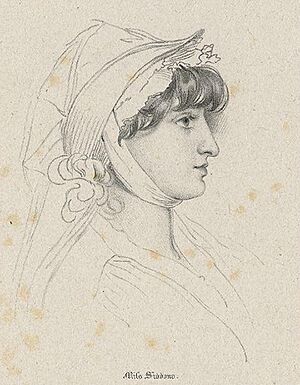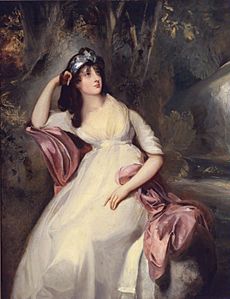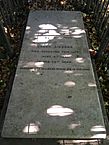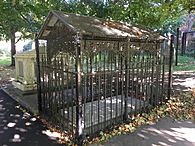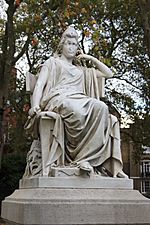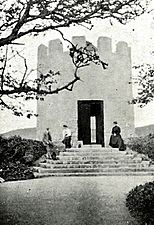Sarah Siddons facts for kids
Quick facts for kids
Sarah Siddons
|
|
|---|---|
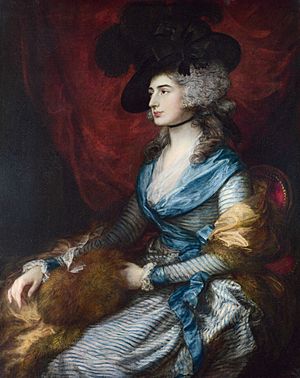
1785 portrait by Thomas Gainsborough
|
|
| Born |
Sarah Kemble
5 July 1755 Brecon, Wales
|
| Died | 8 June 1831 (aged 75) London, England
|
| Resting place | Saint Mary's Cemetery, Paddington Green, London, England |
| Occupation | Actress |
| Spouse(s) | William Siddons |
| Parent(s) | Roger Kemble and Sarah Ward |
| Relatives | John Philip Kemble (brother) Charles Kemble (brother) Stephen Kemble (brother) Ann Hatton (sister) Elizabeth Whitlock (sister) Fanny Kemble (niece) Henry Stephen Kemble (nephew) Mary Frances Scott-Siddons (great-granddaughter) |
Sarah Siddons (born Sarah Kemble; 5 July 1755 – 8 June 1831) was a famous Welsh actress. She was known as the best performer of sad plays (tragedies) in the 1700s. A critic named William Hazlitt once said she was "tragedy personified," meaning she perfectly showed what tragedy was like.
Sarah was the older sister of several other actors, including John Philip Kemble and Charles Kemble. She was also the aunt of the famous actress Fanny Kemble. Sarah Siddons was most famous for playing Lady Macbeth in William Shakespeare's play Macbeth. She made the role her very own.
Today, there is a group called the Sarah Siddons Society, started in 1952. They give out the Sarah Siddons Award every year in Chicago to a great actress.
How Actresses Became Famous
The 1700s saw the start of what we now call 'celebrity culture'. Actresses like Sarah Siddons became very well-known. Newspapers, which were just starting to become popular, shared pictures and stories about actresses' lives. Even if people hadn't seen Siddons act, her name was so famous that crowds would get excited just by hearing she was nearby.
Actresses often dressed like rich people (aristocrats) in their portraits. This made people see less difference between actresses and the wealthy. Many actresses earned a lot of money. Their roles on stage and their real lives sometimes seemed to mix. This helped them create a special public image that people could see both on and off stage.
Sarah's Life Story
Her Early Years
Sarah Kemble was born in Brecon, Wales. She was the oldest daughter of Roger Kemble and Sarah "Sally" Ward. Her father was Catholic, and her mother was Protestant. Sarah and her sisters were raised in their mother's faith. Her brothers followed their father's faith. Roger Kemble managed a traveling theatre group called the Warwickshire Company of Comedians.
Even though many family members were in the theatre company, Sarah's parents first didn't want her to become an actress. At that time, acting was just starting to be seen as a respected job for women.
From 1770 until she got married in 1773, Sarah worked as a lady's maid. Later, she became a companion to Lady Mary Bertie Greatheed at Guy's Cliffe. Lady Greatheed's son, Bertie Greatheed, was a writer who stayed friends with Sarah.
Starting Her Career: Before London Success

In 1774, Sarah Siddons had her first big success. She played Belvidera in Thomas Otway's play Venice Preserv'd. This performance caught the eye of David Garrick, a famous theatre manager. He hired her to act at the Theatre Royal, Drury Lane in London.
However, her first shows in London did not go well. She played Portia and other roles, but she was not experienced enough. The manager of Drury Lane told her that her acting was not needed anymore. Sarah later said she was "banished from Drury Lane as a worthless candidate for fame and fortune."
After leaving Drury Lane, Sarah was quickly hired by Richard Yates, who managed the Theatre Royal, Birmingham. In the summer of 1776, another actor, John Henderson, saw her perform. He was very impressed and said she would be unmatched. He wrote to John Palmer, the manager of the Theatre Royal, Bath, telling him to hire her right away.
In 1777, Sarah began performing in other cities. For the next six years, she worked with theatre companies in places like York and Bath. Her first show at Bath's Old Orchard Street Theatre was in 1778. She earned £3 per week. This amount grew as she became more famous. She also performed in Bristol at the Theatre Royal. Sarah lived with her husband and children in a Georgian house in Bath until her last show there in May 1782.
To say goodbye to Bristol and Bath, Sarah gave a famous speech. In her own words, she showed her three children and said they were her reasons for leaving. She said, "These are the moles that bear me from your side; / Where I was rooted - where I could have died. / Stand forth, ye elves, and plead your mother's cause." She often used her role as a mother in her career.
Her next performance at Drury Lane on 10 October 1782 was very different from her first try. She was an instant hit playing the main character in Isabella, or, The Fatal Marriage. She was so good that her sad portrayal of a mother's sorrow made the audience cry. Critics praised her highly.
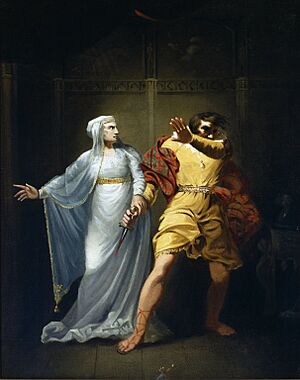
Famous Roles in Her Career
Siddons kept acting in other cities, like The Theatre, Leeds, in 1786. She always deeply understood each of her roles. She was known for studying the entire play script, not just her lines. She would sit backstage to hear the whole play and pay close attention to other actors. This helped her understand the story better.
Her most famous role was Lady Macbeth, which she first played on 2 February 1785. She amazed her audience with her strong emotions. Instead of showing Lady Macbeth as just an evil queen, Siddons showed her with a strong motherly side and a delicate femininity. In Lady Macbeth, Sarah found the best way to use her acting skills. She was tall, had a striking look, beautiful eyes, and a serious, graceful manner. These qualities helped her make the character her own.
After Lady Macbeth, she played other successful roles like Desdemona, Rosalind, Ophelia, and Volumnia. But it was as Queen Catherine in Henry VIII that she found a role almost as good as Lady Macbeth for her acting. She once told Samuel Johnson that Catherine was her favorite role because it felt the most natural.
Playing the Role of Hamlet
Sarah Siddons played the role of Hamlet many times over 30 years. By the early 1800s, Hamlet was one of Shakespeare's most famous characters. It was interesting that she chose this role because playing a character of the opposite gender was usually harder than just wearing men's clothes (a "breeches role"). An actor had to keep the illusion for the whole play.
Siddons played Hamlet many times, but only in cities outside London, until she was 50 years old. She first played Hamlet in Worcester in 1775. Then she played him in Manchester in 1777, with her brother John Philip Kemble as Laertes. She also played Hamlet in Bristol in 1781 and later in Liverpool. In Dublin, she played Hamlet in 1802-03 and again in 1805.
Becoming a Celebrity
Her Public Image as a "Female Star"
Sarah Siddons became the most important actress at Theatre Royal, Drury Lane for 20 years. Her fame was so great it was called "mythical" and "monumental." By the mid-1780s, she was a cultural icon.
According to some experts, Siddons created a new type of female celebrity. She cleverly mixed the characters she played on stage with how she appeared off stage. This allowed her to show two sides to her fans: she could be both "divine and ordinary, domestic and powerful, fantastic and real."
Siddons was good at controlling her public image. She carefully chose her roles to help her popularity and protect her image. By blending her motherly image with how British women were seen, she avoided the scandals that other actresses faced. For example, she used her role as Isabella, a sacrificing mother, to show her rise to fame as both a stage mother and a real-life mother. This helped her show her dedication to her family and her humble life behind the scenes. Her choices meant she had a career with very little public scandal.
Her Powerful Acting
On the night of 2 May 1797, Sarah Siddons played Agnes in Fatal Curiosity. She showed such a strong expression of murder that it made people in the audience feel scared. One person, Henry Crabb Robinson, had trouble breathing and almost had a fit. This "Siddons Fever" was common. People would often faint or have strong reactions, which was part of the fun of watching her.
Siddons sometimes gave public readings of plays. The writer Joanna Baillie saw her perform in 1813. Even though Baillie had some small concerns, she wrote that Siddons' acting was "fine & powerful." She also said that her generation would never see anyone like her again.
Her Portrait as The Tragic Muse
In 1784, the famous painter Sir Joshua Reynolds created a portrait of Sarah Siddons called Sarah Siddons as The Tragic Muse. This painting became the most famous image of tragedy. It showed Siddons' sad expression and posture, reflecting ideas about acting at the time. The painting was so popular that people would visit the owner's house just to see it.
Another painting, Mrs Siddons and Her Son, in The Tragedy of Isabella by William Hamilton, also became very popular. The painter and actress helped each other. Hamilton sold his painting for £150, but he kept it on display for over a week and advertised it in newspapers. People would line up in carriages to see it, ready with their handkerchiefs to show their feelings.
Later Career and Retirement
Sarah Siddons moved from Drury Lane to the Covent Garden theatre in 1802. On 29 June 1812, she gave what many called the most amazing farewell performance in theatre history. The audience would not let the play Macbeth continue after her famous sleepwalking scene. After a lot of applause, the curtain opened again. Siddons was sitting there in her own clothes. She then gave an emotional farewell speech to the audience. Some reports say her speech lasted eight to ten minutes, and she was clearly upset.
Siddons officially retired from the stage in 1812. However, she came back for special events. In 1816, Princess Charlotte asked to see Lady Macbeth, so Siddons performed again. By then, Siddons was older and not as strong. Some critics felt her later performances lacked the power they once had. Her last performance was on 9 June 1819 as Lady Randolph in the play Douglas.
Marriage and Children
In 1773, when she was 18, Sarah married William Siddons, who was also an actor. After 30 years, their marriage became difficult, and they separated in 1804. William passed away in 1808.
Sarah Siddons had seven children, but she outlived five of them:
- Henry Siddons (1774–1815), an actor and theatre manager.
- Sarah Martha (Sally) Siddons (1775–1803).
- Maria Siddons (1779–1798).
- Frances Emilia Siddons (born 1781), who died as a baby.
- Elizabeth Ann Siddons (1782–1788), who died as a child.
- George John Siddons (1785–1848), a customs official in India.
- Cecilia Siddons (1794–1868), who married George Combe in 1833.
Sarah often performed on stage even when she was visibly pregnant. This sometimes made the audience feel more sympathy for her characters. When she played Lady Macbeth while pregnant, it added a motherly side to her performance. It also created new tension in the play, especially since Lady Macbeth and her husband are usually seen as not having children.
Her Legacy
Death and Burial
Sarah Siddons passed away in 1831 in London. She was buried in Saint Mary's Cemetery at Paddington Green. The churchyard became a public park in 1881, and most gravestones were removed. However, Siddons' gravestone was kept. It is still in good condition under a wrought iron canopy, even with some wear and a modern protective cage.
About 5,000 people attended her funeral. Newspapers wrote long articles mourning her death. One said she was "not less eminent for the splendour of her mental endowments, than for the towering majesty of her person and demeanour." She was described as a goddess, royal, and majestic. Her fame continues even today.
The Sarah Siddons Award
In the 1950 film All About Eve, the "Sarah Siddons Award for Distinguished Achievement" was a made-up award. But in 1952, a group of theatre lovers in Chicago created a real award with that name. The Sarah Siddons Award is now very respected. It is given out every year in Chicago, and the trophy looks like the statuette from the movie. Famous winners include Bette Davis and Celeste Holm, who were both in All About Eve.
Portraits and Statues

Many artists painted Sarah Siddons. Some portraits show her in costume, playing a theatre role.
- Sir Thomas Lawrence first painted Siddons in Bath in 1782. He painted her at least 14 times over the next 22 years. His last full-length portrait from 1804 is at Tate Britain.
- Sir Joshua Reynolds painted his famous portrait, Mrs. Siddons as the Tragic Muse, in 1784. He told her he signed it on the hem of her dress because he wanted to be remembered through her. This painting is now at The Huntington in California.
- A 1785 portrait by Thomas Gainsborough is in London's National Gallery.
- A portrait of Siddons is in the church hall of St Mary on Paddington Green Church, near her grave.
- Also on Paddington Green, a statue of Siddons looks over the Harrow Road.
- A statue of Siddons by sculptor Thomas Campbell is in Westminster Abbey. The statue holds a scroll that says: "Sarah Siddons. Born at Brecon July 5, 1755. Died in London June 8, 1831."
- A sculpture by James Smith from 1813 was placed in the Green Room at Theatre Royal, Drury Lane. Ads at the time said it was the only sculpture "taken from life."
Other Memorials
- Siddons Tower, a decorative tower built around 1777 in Ireland, was named after her. Lord Inchiquin named it after Sarah Siddons visited him.
- Siddons Lane, a small street in Marylebone, London, is named after her. She once lived near there.
- Her birthplace, an inn in Brecon, Wales, is now called The Sarah Siddons Inn. When she was born there in 1755, it was a tavern called The Shoulder of Mutton.
- Sarah Siddons' House (the Old House) in Gloucestershire is believed to be her childhood home.
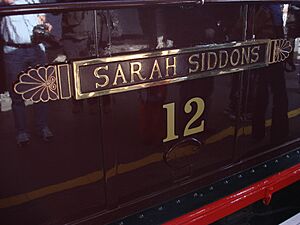
- In 1923, London's Metropolitan Railway named an electric train Sarah Siddons, No. 12. This train was used on the London Underground until 1961. It is now the only one of its kind still working and preserved.
- In 1961, the Sarah Siddons Comprehensive School opened in Paddington. It was a girls-only school that celebrated women's achievements. It closed in 2006.
- In 2020, a special plaque was put up in Worcester where she first performed professionally.
See also
 In Spanish: Sarah Siddons para niños
In Spanish: Sarah Siddons para niños
- Kemble family


